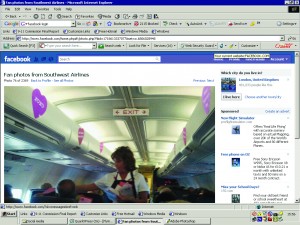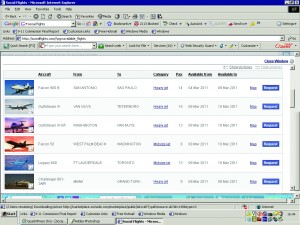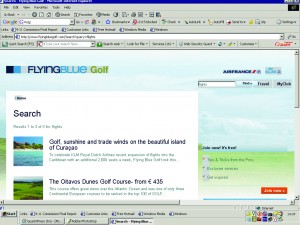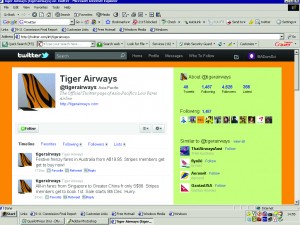Airlines are making ever increasing use of social media sites to reach out and interact with their customers. BILL READ reports on the brave new virtual world of fan pages, loyalty strategies, viral campaigns, influencers and travel tribes.
This is a full article published in Aerospace International: April 2011
Customer interaction in progress. A fan photo of a Southwest flight attendant handing out Valentine’s Day cards to passengers from Southwest’s Facebook page.
In the beginning there were company websites. Now, they are so common that it is generally accepted that the first place to look for information on an airline is on its webpage. There, users can find the latest information on the carrier, its routes, schedules, aircraft fleet, history, news, special offers and travel information. Booking e-tickets via the Internet is now routine and the use of the telephone or a visit to the travel agent is now the exception rather the rule.
But technology is moving on. It is now commonplace to use mobile phones and other handheld devices not just to make phone calls but to take photos, send texts and surf the Internet from almost anywhere in the world.
Recent years have also seen the rise of interactive social media websites where people can engage in virtual discussions, send and receive images, videos and links to websites, or express their views to thousands or even millions of other people around the world. One of the largest social media sites is Facebook where over 500m registered users have a page with details of themselves or a group or event which other visitors can click on ‘like’ if they find it of interest. Users can also contact and interact with ‘friends’ with similar interests. Other leading sites are Twitter, where users can post short ‘tweet’ messages or become a ‘follower’ to receive messages from others, YouTube,where users watch and share videos and the Flickr photo-sharing site.
Aerospace International Contents - April 2011
News Roundup - p4
Making connections - p12
Airlines and social media
Stark choices -p 16
UK Airports face tough choices
UK air power post-SDSR - p 18
Where now for UK air power?
Ready for take-off - p22
Aero India show report
Austerity air support - p 26
Can turboprops make a comeback on the battlefield?
Gateway to growth - p30
Report on Asian Aerospace show
The last word - p34
Keith Hayward compares UK and French industrial strategy
Recognising the marketing opportunities of such sites where they can reach out to hundreds to thousands or even millions of customers, airlines are now rapidly establishing their own presence on them. One company that has wholeheartedly embraced social media is US low-cost carrier Southwest Airlines. Beginning with a blog in 2006, the airlines moved into Twitter and Facebook in 2007 and recently opened its own YouTube video channel, NutsAboutSouthwest, which includes videos of Southwest-related news, events, press conferences, commercials (old and new) and interviews with employees. The airline employs dedicated media staff whose job is to monitor its social media presence for 24 hours a day. It is a big commitment. Southwest was recently reported to have had 12m hits on its website every month, 1.3m Facebook likers, 1m followers on Twitter and 29,000 reviewers on its Travel Guide. The airline also has 20 local station Facebook pages which cover specific Southwest airport operations groups.
Other airlines are starting to venture further into cyberspace. Some carriers have set up social media ‘fanpages’ for frequent flyers which offer special advantages to users, such as TrueBlue Community (jetBlue), Bluenity (Air France/KLM) and AAdvantage (American Airlines). Unlike ordinary company websites, which anyone can access, such sites only offer their best deals to users who sign up to join. For example, Air France is running a competition of the Bluenity site where visitors are given the opportunity to win free flights by guessing where a photo was taken. However, entrants are required to give details of their Facebook information and e-mail — thus adding themselves to the airline’s marketing list. On JetBlue’s TrueBlue site, signed-up members can participate in on-line discussions between themselves and the airline. In February, American Airlines launched an AAdvantage Facebook fanpage which gave random awards to visitors who pressed the ‘Liked’ button on the site. Within less than three days, the number of fans of the site rose from 2,558 fans to 210,000, with many staying to start interacting on the site.Currently, YouTube is less monitored by airlines, although there is plenty of airline content to be found there, including films of aircraft, quirky company commercials and safety videos. A flight safety video for passengers flying on Air New Zealand 737s featuring flight and cabin crew wearing nothing but body paint has been viewed close to 6m times on YouTube while a video from Southwest Airlines on environmentally-friendly engine washing has proved a surprise hit which, when this article was written, had been watched 284,911 times. There are also large numbers of aviation photos on Flickr and some carriers have set up their own virtual galleries there. JetBlue has a Flickr group which allows users not just to share photos but tocomment on them and engage in discussions.
Sites to see
Airlines have also begun to host specialist sites. Delta Airlines has a special Delta Vacations website which allows users to research and book all aspects of holidays which also has links to Facebook (where there are special offers and competitions), Twitter (with interactive discussions with customers), YouTube (offering corporate and customer videos), a blog (where users can share their travel stories and give ratings to hotels and resorts) and an RSS (really simple syndication) news feed. Lufthansa’s MySkyStatus site enables passengers to share their location with Facebook and Twitter friends during the flight. US-low-cost operator AirTran is one of several carriers which has set up a website targetting younger travellers — airtranu.com — which offers specialist cheap flights for 18-22 year olds. Lufthansa also hosts a social network site GenFlyLounge.com aimed at students. Other specialised airline-hosted sites include KLM’s FlyingBlue Golf social media website devoted to air travel and golf and the gay and lesbian travel advice run by Scandinavian Airlines.
Some airlines are monitoring non-aviation websites which are popular with younger ‘media-savvy’ users, such as AirTran which posts videos on collegehumour.com. Over on the new social media site Foursquare, where smartphone users can exchange information on particular cities and other locations that they are at, KLM is running a promotion promising ‘little acts of kindness’ to passengers who follow them on the site which include free flyer miles and discount badges to passengers who check in via the site.
It is not just airlines that are establishing social media links. Aerospace manufacturers, including Boeing, Lockheed Martin and Eurocopter are all actively promoting their activities via social media sites, as are environmental organisations, such as the Air Transport Action Group.
Travel sites
There are also an increasing number of social media sites which allow passengers to exchange information on travel plans so they can meet up on the flight or at hotels. Another recent group of websites (TripIt, Dopplr, planely) allow people to post advance travels plans to their friends so that they can either share the flight or meet up at destinations. The Flyertalk website specialises in frequent flyers exchanging information on travel loyalty reward programmes. Another source of influence are online bloggers with lots of social media followers. Their views are important to airlines, as lots of other people read what they say.
When choosing which airline to fly on, people like to know what other travellers had said about them. To help them make an informed choice, Internet travel review sites allow users to compare air fares, book flights and to write up their comments on places they have been to, hotels they have stayed at — and airlines they have flown on. The Skytrax site has 3m reviews of over 670 airlines and 700 airports. The site has a 1-5 star ranking for airlines and presents an annual World Airline Award to the top 5 star carrier (won in 2010 by Asiana Airlines). The site includes detailed descriptions of customer’s experiences of an airline’s website, airport check-in and flight experience — including the condition of the aircraft, helpfulness of staff and quality of food. Only one airline achieved a 1 star ranking — but you’ll have to look at the site to see which one it was!
Unlike individual airline Facebook or Twitter sites which run the risk of being dominated by a few correspondents with particular issues, travel sites have the advantage that their reviews come from many different customer experiences and thus give a more accurate picture of an airline’s overall service. A good travel review is therefore worth having and airlines often include links to the best ones on their own sites.
Business flights for all

A page from the Social Flights website showing private or business aircraft flights with empty seats available.
Social media has also enabled a unusual and innovative venture into business aviation. A website called Social Flights — tagline ‘air travel without the hassles’ — enables individuals and groups who would normally have flown on commercial airlines to access information about private or business aircraft flights with empty seats available. A recent vist to the site included such offers on ‘empty leg’ trips for up to 14 passengers on a Falcon 900B between San Antonio and Sao Paulo between 4-9 March or six seats on a Beechjet 400A from Naples to Panama City on 9 March. The private aircraft operators benefit from extra revenue on otherwise non-earning journeys while customers can not only enjoy the benefits of private aviation travel at a fraction of its usual cost but can also find ‘point-to-point’ flights linking many more airports than are served by commercial carriers. To reduce the individual cost, customers use social sites such as Facebook to join ‘travel tribes’ — groups of people who want to go to the same destination, perhaps to attend a sporting or other event.
Branding and loyalty
Two words that crops up frequently in discussions about airlines and social media are ‘branding’ and ‘loyalty’. Branding has many meanings to different people but one definition might be the image created by an airline which makes it different from another. The aim of successful branding is to make the image memorable enough to differentiate it from others in the mind of the user. Having established a brand, the next step is to ensure that people think of it as a positive image that they want to be associated with and would recommend to others — which is where loyalty comes in. “Like many others, airlines have been slow in utilising social media to build relationships and engage with their vast base of loyalty programme members,” comments Stuart Evans, UK general manager of loyalty marketing specialists ICLP. “Rather than just solving customer service issues, there is a missed opportunity here for airlines who are their most loyal customers, such as their loyalty programme members and build brand advocates, which is the ultimate aim for any social media programme.”
When things go wrong
Airlines with a strong positive brand can use social media to reinforce it. However, for those carriers which have acquired a bad reputation, for whatever reason, social media often serves only to reinforce it. One of the most wellknown incidences in which an airline got it wrong was in 2009 when Canadian musician Dave Carroll posted a music video on YouTube describing his failure to get compensation from United Airlines for a damaged guitar after eight months of complaints. The song ‘United breaks guitars’ proved to be a worldwide hit and a public relations disaster for United. The song is still on YouTube and has now been viewed over 10m times.Even airlines that actively monitor their social media sites to respond to customer concerns can still run into trouble. It is a fact of human nature that more people will complain about a bad experience than will talk about a good one. There are several other incidents of passenger complaints ‘going viral’ and being publicised across the world. One recent case involved US film director Kevin Smith who was ordered off a Southwest Airlines flight because his extreme weight made him a safety risk. Smith used Twitter to publically vent his rage against the airline to his 1.6m followers. Although Southwest was monitoring Twitter messages and responded with apologies, the damage to the airline was already done.
Another well-publicised incident was in December 2008 when Virgin Atlantic passenger Oliver Beale wrote a quirky complaint letter to Richard Branson concerning the quality of his airline’s food. Copies of the letter, complete with photos of the food, spread around the Internet and into newspapers. However, the situation was turned into a publicity success story by the carrier’s public relations team who spread the news that Richard Branson had phoned Mr Beale and invited him to help select food and wine for future flights — perhaps proving Oscar Wilde’s well-known saying that: “There is only one thing worse than been talked about and that is not being talked about.”
Maintaining control
One area of debate is the degree of control that airlines should exercise over their social media sites. While it is good for the airline’s image to see positive customer comments posted on their site, it is not so good when there are complaints — even if they are dealt with quickly. However, any attempt to censor negative comments may only lead to further trouble as customers express their views through other channels — some of which may be very negative indeed. Twitter users created a ‘hate site’ for Jet2, called Jet2.con while Ryanair has been conducting an on-going battle with its critics who set up an anti-Ryanair website ihateryanair.co.uk. The airline managed to get the site closed in October 2010 on a legal technicality but the protesters responded by opening a new site at ihateryanair.org.
Even on a well-maintained social media site, airlines have to be constantly on their toes. Having established a social media presence, they need to use it. There is no benefit, for example, for a carrier to open a special Twitter account to interact with its customers if no one from the company uses it to interact with customers and reply to issues that they raise.
Another problem is that it is no good for an airline to have a strong social media presence, if it is not matched by actual customer experience in the real world. Every employee is an ambassador for an airline — be it pilot, flight attendant, baggage handler, check-in staff or even someone who answers an e-mail or the telephone. Any passenger that feels they have been treated badly now has the power to share their experience with the rest of the world. It only takes one bad passenger experience from one employee working anywhere in an airline to undo the good customer relation policy being adopted by everyone else. It is vital, therefore, that all the staff of an airline are aware of its social media presence — even those with no direct contactwith that side of the business. Mindful of this fact, social media pioneers Southwest organised a recent internal social media conference (BlogCon) to train their employees in the use and creation of social media.
Positive and negative
There have been good and bad examples of the use of aviation and social media. In the days immediately after the Icelandic volcanic ash cloud had closed much of Europe’s airspace, Eurocontrol provided updates and information on the developing situation through its website, Facebook page and Twitter feed, while many airlines put updates and interactive dialogues on their own Facebook pages on what flights were starting to resume. KLM used interactive Twitter feeds to keep passengers informed while Lufthansa re-tweeted messages from passengers at airports around the world who had access to the latest information.However, there are also downsides. Sometimes messages are inaccurate. In a recent radio interview on the November 2010 Qantas A380 flight QF32 engine incident, Qantas ceo Alan Joyce claimed that inaccurate reports on Twitter that the aircraft had crashed had caused the airline’s share price to collapse. After the Haitian earthquake, a false rumour was posted on Twitter that American Airlines were offering free flights to Haiti for medical staff — which the airline then had to deny. Airline employees have got into trouble with their employers for posting adverse comments about the airline or passengers on social media sites — Virgin Atlantic even going so far as to sack 13 flight attendants in 2008 for remarks posted on Facebook. There have also been cases of deliberate abuse by users. KLM’s ‘little acts of kindness’ viral promotion mentioned earlier in this article backfired when tweeters used the hashtag #klmsurprise to send negative comments straight to the company’s website.
One area of concern with social media is that ‘passenger power’ has gone too far and that airlines are having to devote too much time and resources to mollify a small number of vociferous customers with possibly unjustified or trivial complaints. It is worth noting that, although social media may appear to enpower all airline users to express their views, the playing field is not level for everyone. Passengers who are not online have no voice at all and cannot buy special promotions and discount fare offers. Those users who are online may be judged in importance by the number of the people who follow them. Thus, a passenger with a grievance who telephones or writes a letter to an airline is not likely to be treated the same way as a more important ‘influencer’ who has millions of Twitter followers. One influential airline blogger reported how he had sent out a tweet saying that they were about to fly economy on Kingfisher Airlines. The message was picked up by the airline which then provided him with special treatment, including access to the airline lounge at Dubai and first service from the meal trolley. Virgin America is also reported to have given away free flights to social media influencers it has identified on Twitter.
But can it make money?
Another topic of debate is that of money. Not all airline decision makers are yet convinced of the value of social media, some still taking the view that it is a fad which has little influence on sales and costs too many resources to maintain. Low-cost carrier Ryanair is an outspoken opponent of social media and does not have any such links on its website. In January, UK low-cost operator Jet2 shut down its Twitter account because it couldn’t devote enough resources to maintaining it.Advocates of social media sometimes find difficulty in convincing the ‘bean counters’ that their presence in the virtual marketplace enhances an airline’s bottom line. Airline marketeers are naturally keen to try to take advantage of traffic through their social media sites to sell other products and services.
However, many users find online adverts an irritation, preferring to base their decisions on comments from other social media users. Despite this, social media advocates argue that, provided that the airline has a positive attitude towards passengers in cyberspace and the real world, then people will remain loyal to the carrier and will encourage others to do so. Secondly, social media is an ideal medium for carriers to sell off any unsold seats on flights at short notice — seats that would otherwise not generate any revenue. United Airlines and JetBlue both offer last minute cheap fare offers on Twitter (known as Twares and Cheeps, respectively). Southwest Airlines has started announcing special fare sales only through Twitter — with great success.
Big airline is watching you?
So, what is the future for airlines and social media sites? The virtual marketplace is still evolving and it is not yet clear how how far it will go. Those carriers that have made big investments in their social media links to interact with their customers have reaped benefits (and a few brickbats) but it is on-going commitment that will need to be maintained over time. As more and more airlines set up social media links, it may become more difficult to attract customers’ attention, as the market becomes flooded with different brands and special offers. Up to now, it is airline customers who have been the most proactive — voicing their opinions about the airlines and gaining a few perks along the way. Airlines have mostly been reactive but this may start to start to change. There is a wealth of potential customer information in cyberspace, if you know which is relevant and how to get it. It is possible for an airline to compile individual profiles of each of their customers (and potential future customers): their likes and dislikes, what products they buy, where they like to travel, their friends, and so on.
In his blog from the recent Asian Aerospace show, AI editor Tim Robinson reported on a concept from Sergio Mello, ceo of Satisfly, which allows airlines and passengers to utilise information available from social media networks to their own advantage. Passengers could be allocated a seat next to someone with similar views or tastes (or even to someone who wanted no talk at all) while airlines could build up highly personalised passenger profiles. He reports, “someone might post a message on their Facebook page saying ‘bored — want a holiday’. An airline could reply with a tweet offering him or her a special deal to their favourite city and also tell them that their long-lost friend will be in town at the same time. Checking in —they are allocated seats next to someone who has the same interests and the inflight entertainment system could suggest films and TV shows they had forgotten they loved.”
While some people may feel that this scenario has somewhat Orwellian overtones with regards to personal privacy, others may welcome the opportunities it offers. So, next time you want to travel anywhere, make sure you tell everyone you know on Facebook and tweet it out on Twitter. You never know what might happen next.
This is a full article published in Aerospace International: April 2011. As a member, you recieve two new Royal Aeronautical Society publications each month - find out more about membership.






